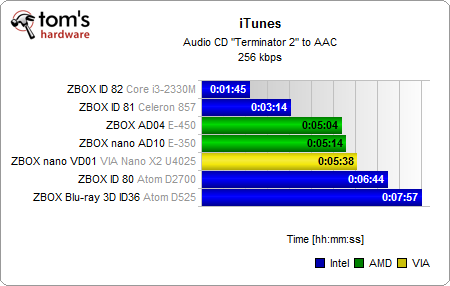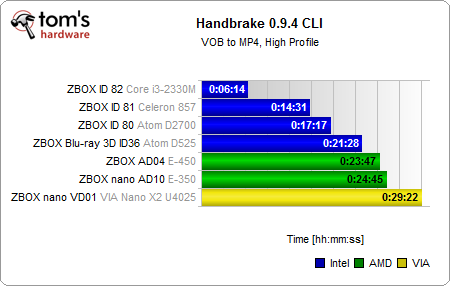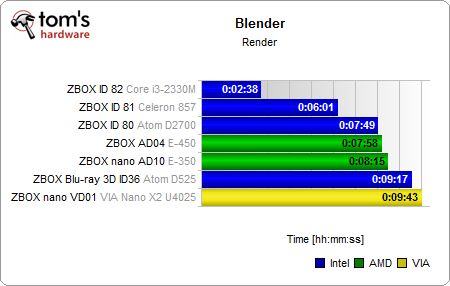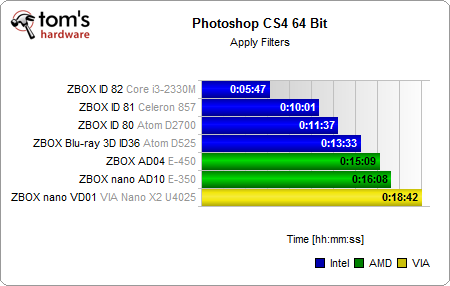Good Things In Small Packages: Seven Nettop Platforms, Tested
It'd be easy to dismiss nettops as underpowered attempts at miniaturization, but they’re good enough for surfing the Web, writing emails, and watching some video. Today, we're comparing seven different platforms based on CPUs from Intel, AMD, and VIA.
Audio And Video Conversion, Rendering, And Photoshop
Audio Conversion: iTunes and Lame
It’s not too farfetched to assume a nettop will be used to compress the occasional music file. After all, some models, such as the Blu-ray version of Zotac’s Zbox, as well as some units from Shuttle, come with an optical drive.
Both of these audio converters use only one thread, resulting in identical performance rankings. The mobile Core i3 and the Celeron, both not really nettop parts, hold on to their positions at the top of the charts, followed by AMD's APUs. VIA pulls off another surprise, as its Nano X2’s IPC advantage lands it ahead of the Atoms.
Video Conversion: MainConcept and HandBrake
Nobody is going to buy a nettop to use primarily for video transcoding, but you may want to convert a short clip for playback on a smartphone or tablet every once in a while.
Unlike the audio benchmarks, the motto here is definitely "the more, the merrier" when it comes to threading. So, while superior IPC allowed AMD and even VIA to make a strong showing in the audio tests, their dual-core designs put them at a disadvantage compared to the Hyper-Threading-equipped Atoms. Although Intel's Sandy Bridge-based parts lack Hyper-Threading, their more powerful desktop architecture kicks in to facilitate impressive-enough times to take first and second place.
Rendering: Blender and 3ds Max 2010
Get Tom's Hardware's best news and in-depth reviews, straight to your inbox.
Rendering is another discipline not necessarily relevant to entry-level machines. But, just for kicks, lets see how our candidates fare when confronted with heavy workloads in Blender and 3ds Max.
Blender yields a similar finish as our transcoding tests, but 3ds Max shakes things up a little. Interestingly, VIA’s Nano X2 can not only beat out AMD’s dual-core E-350, but also Intel's quad-threaded Atom D525 as well. Not bad for a CPU that debuted shortly after Intel’s first-generation Atom chips more than five years ago. It takes an E-450 to outmaneuver VIA’s little CPU-that-could. Core i3, Celeron, and Atom D2700 take the first three places, though.
Photoshop CS4: Apply Filters
Our Photoshop test applies various threaded filters to a large image. This time around, we get to see what even logical cores can do for performance, as the quartet of Intel CPUs sweeps the top of the performance chart. Despite its surprisingly good IPC, VIA’s Nano X2 brings up the rear, and AMD’s APUs slot in ahead of it.
Current page: Audio And Video Conversion, Rendering, And Photoshop
Prev Page Cinebench, File Compression, And PDF Creation Next Page Web Benchmarks, Video Playback, And Power-
falchard I think this review is bias. Its missing the AMD small form factor benchmark. Any game.Reply -
A Bad Day JOSHSKORNIn all honesty, when it can run Crysis...I'll be impressed. Until then...alrighty.Reply
Well, if you run it in:
-320p resolution
-Directx 8
-All eyecandy off
You'll get around 5-10 FPS. -
bavman These things suck. Why would you dish out the $300-400 theyre asking for them? I recently built a file server that was basically a dumbed down tower with an g620 cpu, 4 gigs of ram for under $200 (excluding all the hdds). Throw in a $50 graphics card and it would dominate any of these nettops.Reply -
friskiest bavmanThese things suck. Why would you dish out the $300-400 theyre asking for them? I recently built a file server that was basically a dumbed down tower with an g620 cpu, 4 gigs of ram for under $200 (excluding all the hdds). Throw in a $50 graphics card and it would dominate any of these nettops.Reply
You pay for the size, power and niche factor in here,.. these are Nettops,.. you're not supposed to play AA or AAA games in here,. just browse the net,. watch movies and listen to music- as implied
-
Nintendo Maniac 64 What I really want to see is a nettop using AMD's 17w A6-4455M. Being a Trinity APU, it actually WOULD have enough grunt to run Crysis, and without it looking like crap to boot!Reply -
molo9000 Shame these still aren't good at H.264 decoding. They would make great HTPCs.Reply
The hardware decoding of the VIA chipset would be a killer feature, if there actually was some software that supported it. Seems like XBMC doesn't support it either. -
daglesj I rolled out a load of Ion 330 Asrock boxes a couple of years ago for business use. Customers still love their little black boxes. These were the early 1.6Ghz dual core Atoms.Reply
For work use (basically 95% of what 95% of the worlds computers users actually do in the REAL world) they work great.
There is more to life than endless benchmarking and Crysis.






